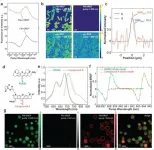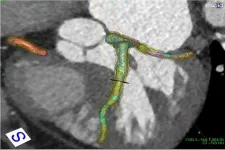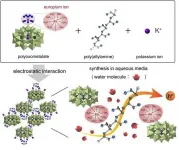Vibrational microscopy goes super resolution
2021-04-21
(Press-News.org) It has been a long pursuit to develop super-resolution imaging techniques for Raman microscopy, which has intrinsic advantages of chemical specificity over the fluorescence counterpart. Despite the perceived importance and extensive research efforts, true super-resolution (defined as diffraction-unlimited) Raman imaging of biological systems in the optical far-field remains challenging due to the deficiency in sensitivity for conventional Raman scattering. Consequently, those reported super-resolution vibrational imaging methods have to base on excitation saturating, depleting, or high-order nonlinearity of the Raman transitions. These require extremely intense laser power in order to achieve a moderate resolution improvement (often less than a factor of 2), which inhibits the utility for biological application.
In a new paper published in Light: Science & Application, a team of scientists, led by Professor Wei Min from Columbia University, USA, has developed a novel super-resolution vibrational microscopy harnessing Stimulated Raman Excited Fluorescence (SREF) as an ultrasensitive vibrational contrast. SREF couples the vibrational excitation with fluorescence detection and enables all-far-field Raman spectroscopy with sensitivity down to single-molecule. However, direct coupling of stimulated emission depletion (STED) with SREF imaging fails to achieve super-resolution imaging due to the presence of the anti-stokes fluorescence background, which cannot be depleted by the STED beam.
In this new work, the team devised a frequency-modulation (FM) strategy to remove this broadband background. By temporally modulating the excitation frequency on- and off- the targeted vibrational resonance but still within the background's broad linewidth, they can generate an intensity modulation on the pure vibrational signal (but not on the background). The background-free vibrational signal can be subsequently demodulated by a lock-in detection. Comparing with the typical raw SREF spectrum, the spectrum acquired by FM-SREF represents the pure SREF signal, which enables high-contrast background-free SREF imaging. They further synthesized new isotope-edited SREF dyes to facilitate multicolor FM-SREF biological imaging with sharp vibrational contrast. Two vibrational colors are separated by FM-SREF with minimal cross-talk, which is nearly impossible by conventional fluorescence microscopy. Such chemical specificity of vibrational imaging has unique advantages for multiplexed optical imaging.
Finally, by integrating STED with background-free FM-SREF, they accomplished high-contrast super-resolution vibrational imaging with STED-FM-SREF, whose spatial resolution is only determined by the signal-to-noise. They demonstrated more than two times resolution improvement in biological systems with moderate laser excitation power. With future optimization on the instrumentation and imaging probes, STED-FM-SREF microscopy is envisioned to aid a wide variety of biological applications, with its superb resolution, high sensitivity, unique vibrational contrast, and biocompatible excitation power.
INFORMATION:
[Attachments] See images for this press release:

ELSE PRESS RELEASES FROM THIS DATE:
2021-04-21
The Endangered dryas monkey (Cercopithecus dryas), endemic to the Democratic Republic of the Congo, is one of Africa's most mysterious primates. The discovery of the dryas monkey killed by a hunter in the buffer zone of Lomami National Park in 2014 has prompted field research of this small species (5-7 pounds). However, they are difficult to detect because they live in dense vegetation in secondary forest thickets.
Using non-invasive research and no-flash camera traps from 2014 to 2019, scientists from Florida Atlantic University in collaboration with researchers from the FZS-Lomami Project, Democratic Republic of the Congo, now have picture-perfect details on this elusive species. They have confirmed ...
2021-04-21
Astronomers have discovered a pulsar--a dense and rapidly spinning neutron star sending radio waves into the cosmos--using a low-frequency radio telescope in outback Australia.
The pulsar was detected with the Murchison Widefield Array (MWA) telescope, in Western Australia's remote Mid West region.
It's the first time scientists have discovered a pulsar with the MWA but they believe it will be the first of many.
The finding is a sign of things to come from the multi-billion-dollar Square Kilometre Array (SKA) telescope. The MWA is a precursor telescope for the SKA.
Nick Swainston, a PhD student at the Curtin University node of the International Centre for Radio Astronomy Research (ICRAR), made the discovery while processing data collected as part ...
2021-04-21
Coronary artery disease (CAD) is the most common form of heart disease and is present in about END ...
2021-04-21
Protons are the next big thing when it comes to fuel cell technology. The subatomic exchange produces power on a scale that challenges contemporary solid-state fuel cell technology, used to help power space shuttles. To realize the proton-based technology sooner, an international team of researchers have developed a hybrid material that effectively transports protons at high temperatures and humidity -- two major challenges in past attempts.
The results were published on April 19 in ACS Applied Materials & Interfaces, a journal of the American Chemical Society.
The team, led by ...
2021-04-21
A new Portland State study challenges the idea that youth with cognitive disabilities are unable or lack potential to pursue a career in science, technology, engineering and mathematics.
In a study using national data on more than 15,000 adolescents, the researchers found that undergraduates with medicated ADHD or autism appear to be more likely to major in STEM than youth without cognitive disabilities, and youth with autism have the most positive STEM attitudes.
Dara Shifrer, the lead author and an associate professor of sociology at PSU, says that increasing access to STEM fields for youth with disabilities depends not only on encouraging them to pursue STEM majors but also to enroll in college because STEM occupations often require bachelor's degrees at ...
2021-04-21
Graphene is a two-dimensional material in which carbon atoms are arranged in hexagonal structures, and it has unique physical and chemical properties such as sub-nanometer thickness, chemical stability, mechanical flexibility, electrical and thermal conductivity, optical transparency, and selective permeability to water. Due to these properties, various applications of graphene in transparent electrodes, desalination, electrical energy storage, and catalysts have been vigorously studied.
Because graphene is an extremely thin material, for practical uses, it has to be deposited on top of other materials that serve as substrate. One of the research subjects which is of great scientific ...
2021-04-21
Osaka, Japan - Catalysts lie at the heart of a greener and more sustainable future for chemical production. However, many of the catalysts currently in widespread use have limitations that affect their efficiency. Researchers from Osaka University have reported a stable and reusable nickel phosphide nanoalloy catalyst for the hydrogenation of maltose to maltitol that outperforms conventional catalysts. Their findings are published in ACS Sustainable Chemistry & Engineering.
Maltitol is a sugar alcohol that is widely used as a sweetener and food additive. It can be produced by hydrogenating maltose; however, the reaction must be selective to avoid generating ...
2021-04-21
DALLAS, April 21, 2021 -- A smartphone-based electrocardiogram (ECG) screening accurately detected previously unknown atrial fibrillation in American Indians, and more than half who were diagnosed with the irregular heart rhythm were younger than the recommended screening age of 65, according to new research published today in the Journal of the American Heart Association, an open access journal of the American Heart Association.
About one-third of ischemic strokes, those triggered by blood clots, are caused by atrial fibrillation, the most common heart rhythm disorder. Since many people don't have symptoms and are unaware of its presence, atrial fibrillation often goes undiagnosed. In some cases, a stroke is the first sign that a person has the ...
2021-04-21
Volcanic eruptions deep in our oceans are capable of extremely powerful releases of energy, at a rate high enough to power the whole of the United States, according to research published today.
Eruptions from deep-sea volcanoes were long-thought to be relatively uninteresting compared with those on land. While terrestrial volcanoes often produce spectacular eruptions, dispersing volcanic ash into the environment, it was thought that deep marine eruptions only produced slow moving lava flows.
But data gathered by remotely operated vehicles deep in the North East Pacific and analysed by scientists at the University of Leeds, has revealed a link ...
2021-04-21
Researchers at Linköping University, Sweden, have developed a stable high-conductivity polymer ink. The advance paves the way for innovative printed electronics with high energy efficiency. The results have been published in Nature Communications.
Electrically conducting polymers have made possible the development of flexible and lightweight electronic components such as organic biosensors, solar cells, light-emitting diodes, transistors, and batteries.
The electrical properties of the conducting polymers can be tuned using a method known as "doping". In this method, various dopant molecules are added to the polymer ...
LAST 30 PRESS RELEASES:
[Press-News.org] Vibrational microscopy goes super resolution







